

RescueWare is the first end-to-end solution to automate, simplify and speed the transformation of legacy systems to component-based architectures and modern technology platforms. RescueWare is a graphical, repository-based Windows application with an intuitive and fully integrated workflow for re-hosting legacy systems. This integrated solution provides revolutionary technologies for the analysis, transformation and forward code generation, to convert legacy systems into modern platforms and languages, such as C++, Java and Visual Basic.
RescueWare also provides Year 2000 and European Monetary Union (EMU) analysis and remediation as part of the transformation solution. Customers can remediate their systems while capturing all the information required to transform these systems, providing significant value beyond the year 2000.
What is Legacy Transformation?
Legacy Software Transformation refers to the process of
migrating systems from older computing environments to modern
computing platforms. It is more than just converting code from
one language to another. It is the conversion of programming
paradigms, user interfaces, and database structures. To achieve
complete system transformation:
- Monolithic inline process code must be partitioned and transformed into objects.
- Character-based block mode displays must be transformed into event-driven GUI screens.
- Flat file, hierarchical or network data structures must be transformed into ANSI standard SQL.
- Once transformed, the business rules and application data from a legacy system remain unchanged, but now run in a modern computing environment.
Companies have invested millions of dollars and years of development building their business critical information systems. If these legacy systems are to remain viable, then it is paramount that they be transformed to modern platforms and languages which can dramatically enhance the usability and maintenance of these systems.
RescueWare® Overview
With over 200 person-years of development, RescueWare provides
integrated support for all stages of legacy transformation including
component mining and complete application transformation. RescueWare
combines powerful functionality, a visual user interface and integrated
workflow to automate the transformation of legacy systems to modern
computing environments.
Using a proven methodology that virtually walks users through the entire process, RescueWare automates legacy system inventory and analysis including Year 2000, business rule extraction, screen event mining, data modeling and code partitioning into objects. RescueWare uses the extracted and transformed information to convert these systems into object-based event-driven computing paradigms, generating modern user interfaces, program code and database definitions.
A typical legacy system is composed of hundreds of programs and frequently millions of lines of code. RescueWare provides substantial improvements in productivity by providing an understanding of what parts of the system need to be moved forward and then automating the transformation process.
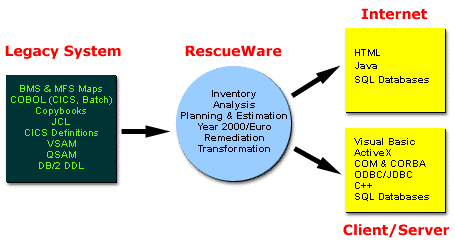
Highly sophisticated in its overall design, RescueWare employs complex mathematical models to deliver a remarkably powerful, flexible and scalable solution that streamlines the process of legacy system transformation. RescueWare delivers an unprecedented level of ease-of-use through an intuitive, graphical "workbench" that combines easy-to-follow windows-offering views of both existing legacy code and newly transformed application components. This visual interface is complemented by an embedded methodology that advances users through a step-by-step process of code mining and system transformation.
RescueWare automates the mining of legacy system components from:
User Interface
![]() Screen Maps
Screen Maps
![]() Screen and process flow logic in CICS and COBOL programs
Screen and process flow logic in CICS and COBOL programs
Business Logic
![]() COBOL programs (on-line and batch)
COBOL programs (on-line and batch)
Data
![]() Program data definitions (parameters and working storage)
Program data definitions (parameters and working storage)
![]() VSAM and flat file definitions
VSAM and flat file definitions
![]() ANSI standard DDL, such as DB/2 relational database DDL
ANSI standard DDL, such as DB/2 relational database DDL
With the resulting extractions, RescueWare then generates:
![]() Native graphical interfaces for Java, HTML, Visual Basic, and C++
Native graphical interfaces for Java, HTML, Visual Basic, and C++
![]() Business logic in Java, C++ and Visual Basic
Business logic in Java, C++ and Visual Basic
![]() Database Definitions for popular databases - Oracle, Sybase, Informix, MS
Database Definitions for popular databases - Oracle, Sybase, Informix, MS
![]() SQL Server, and DB/2, as well as ODBC, JDBC, and static SQL CRUDs;
SQL Server, and DB/2, as well as ODBC, JDBC, and static SQL CRUDs;
![]() Support for industry standard architectures such as Microsoft's
Support for industry standard architectures such as Microsoft's
![]() ActiveX/DCOM and CORBA
ActiveX/DCOM and CORBA
The Integrated RescueWare Solution
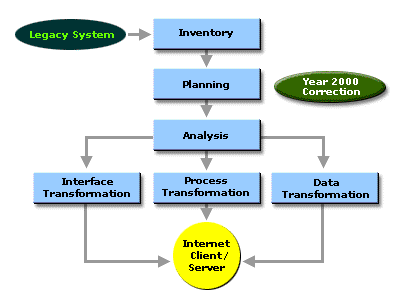
Within a single product, RescueWare automates most aspects of legacy
systems modernization:
- Inventory
- Planning & Estimation
- Analysis
- User Interface Transformation
- Process Transformation
- Data Transformation
- Year 2000 Correction
System Inventory
Creating an inventory of an existing legacy application provides an
important first step to scope, organize, and manage the legacy
transformation process. The purpose of this is to have a complete and
accurate portfolio of all software components within a specified
application. The user creates a named project where each identified
component is stored within the RescueWare repository. Components are stored
and categorized by type.
The legacy components can be subsequently verified for completeness and correctness of source, and cross-referenced for missing items. A comprehensive inventory report can be produced for project verification, including missing and unused source files. Legacy objects that can be registered into the RescueWare repository include:
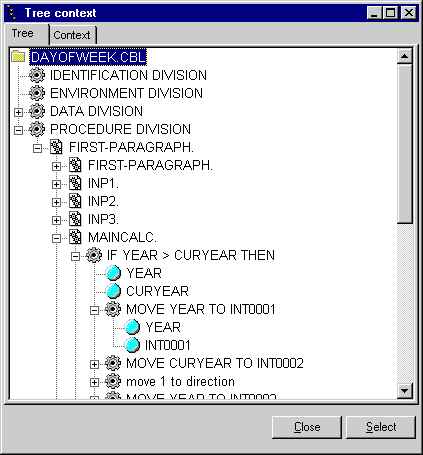
A Hyperview Representation of a Cobol Program
User Interface
![]() CICS BMS screen maps, mapsets, FCT and PCT definitions
CICS BMS screen maps, mapsets, FCT and PCT definitions
![]() AS/400 DDS screen definitions
AS/400 DDS screen definitions
Business Logic
![]() COBOL source
COBOL source
Data definition
![]() COBOL copybooks
COBOL copybooks
![]() VSAM and Flat File definitions
VSAM and Flat File definitions
![]() DB2 DDL
DB2 DDL
RescueWare provides an easy to use interface for registering these components. Reports can be viewed online or exported as text or in Microsoft Excel format.
Project Planning and Estimation
RescueWare Planning and Estimation dramatically facilitates the project
planning process by automating the sizing and scoping of complex
transformation or Year 2000 projects. RescueWare is ideal for project
managers that are responsible for accurate and complete estimates on
project resources and
delivery timeframes.
The user is given considerable flexibility in establishing project and organization specific heuristics. The planning and estimation process begins by establishing project dependent complexity criteria and the corresponding work efforts for each type of legacy component. RescueWare assists the user in measuring and assigning complexity to each individual legacy component. The combination of complexity counts by component type and the associated work efforts lead to the creation of project plans and required resource estimates.
The output of RescueWare can be used directly or be imported into Project Management tools such as Microsoft Project 98.
System Analysis
RescueWare provides the industry's most advanced tools for the analysis of
legacy systems. These tools help the user attain an in-depth understanding
of the business knowledge embedded in
a legacy system.
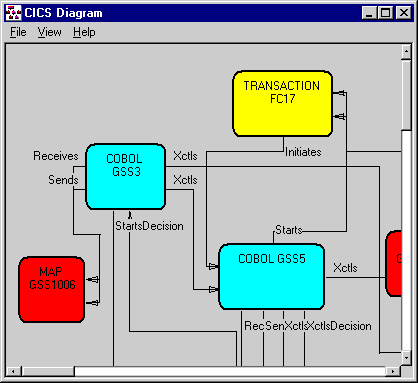
A CICS Transaction Flow Diagram Automatically Generated by RescueWare
Some of the facilities include:
- HyperView, a very powerful legacy visualization facility that presents original Cobol program source, screen flows, DDL, and JCL in a highly graphical, easy to comprehend form.
- System visualization diagrams that allow users to study system call dependencies, CICS control flows, and legacy database schemas.
- Viewers and editors for 3270 and AS/400 screen maps.
Application Interface Transformation
One of the most time consuming aspects of legacy system rehosting is
transforming character-based block mode displays into event-driven GUI
screens. RescueWare provides extensive automation to assist in this
transformation process.
Legacy systems typically process data from online screens in a sequential fashion. To take advantage of the object and event-based architectures of the new technology platforms, transformation of both application screens and the underlying architecture are required.
RescueWare provides a revolutionary new approach with its Event Mining Facility. This analyzes the entire online system, and in a highly automated and interactive fashion, locates the COBOL code driving each event in the user interface, and explores and links the "logic".
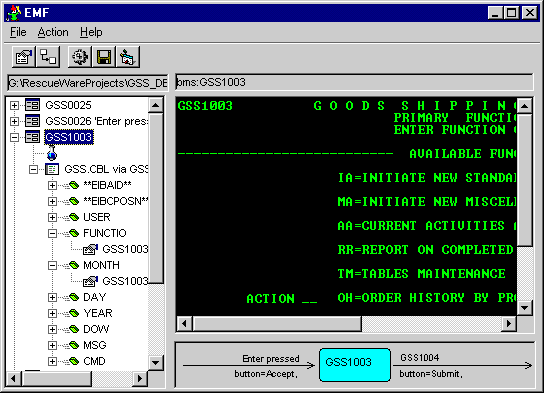
RescueWare event mining facility view of the BMS map and
window flow. Left pane defines events within the system.
RescueWare identifies the process and flow of the user interface, translating BMS maps into Visual Basic, HTML, C++ or Java-based graphical user interface. A multi-pane screen displays the raw code, the legacy interface and interface events. A new window flow is recommended. This can be enhanced with a visual inspection of the system. RescueWare also provides an emulation feature to prototype the new user interface, and allows for generation once the user is satisfied. The output of this facility is a complete Visual Basic project, HTML screens, or a Java or C++ application. The developer can then use any appropriate development tool to complete the modernization of the user interface.
Application Process Transformation
RescueWare provides for the automated transformation of the most important
component of a legacy application-the business logic. It is highly flexible
in transforming the entire system, or parts of it to modern platforms and
architectures. The key RescueWare facilities that enable this include
Business Rule/Component Extraction, Application Partitioning and Business
Object Generation.
Business Rule/Component Extraction
Knowledge of the business is usually embedded within the legacy system.
After the programmers that created the legacy systems are long gone, the
knowledge of how computations are done, data is processed and the
application workflow exists only within the code. New systems that are
being created can often use components of these legacy systems, however
extracting this logic is very difficult.
RescueWare provides a revolutionary new solution to this problem. Based
on the selection of a data attribute, RescueWare can automatically
"slice" the entire business rule or component from the program and
present it visually or as a new object. This allows for the extraction
of valuable business logic from within the legacy system. The extracted
object can be saved as a reusable component in Cobol, or transformed to
any of the supported languages and platforms.
Application Partitioning
Legacy systems typically consist of large monolithic programs that process
data sequentially. Directly transforming the code to a new language may
limit the usefulness of that code. What is required, in addition to
language transformation, is the ability to partition the legacy systems
into smaller reusable objects.
The RescueWare Application Partitioning Facility is one of the most sophisticated and innovative components of the product. It uses a set of proprietary mathematical algorithms to break monolithic, single platform legacy programs into groups of self-contained, encapsulated blocks of business logic with well-defined interfaces. Each of these logic blocks can be deployed independently to the different nodes of a heterogeneous distributed system. Advanced data flow analysis utilizes sophisticated graph theory algorithms to minimize data coupling between these logic blocks.
The user has additional flexibility to adjust the packaging boundaries of these logic blocks. For example, some of the logic blocks can remain externally accessible, some of them can be incorporated into other external packages as internal procedures, and some of them can be eliminated altogether by turning them into inline code. As a final activity, the user can target each of the logic blocks to a particular platform.
Business Object Generation
RescueWare Business Object Generation allows the legacy Cobol code to be
transformed to any supported target language. The entire Cobol program,
extracted Business Rules/Components
or partitioned objects can be transformed to the new languages.
When the RescueWare Application Partitioning Facility is used to specify objects for different platforms, the wrappers to the target middleware are also generated automatically.
Supported languages include:
Client
![]() Java
Java
![]() HTML
HTML
![]() Microsoft Visual Basic
Microsoft Visual Basic
![]() C++
C++
Server
![]() Java
Java
![]() C++
C++
Middleware
![]() Microsoft ActiveX/COM
Microsoft ActiveX/COM
![]() CORBA
CORBA
![]() JavaBeans
JavaBeans
Application Data Transformation
RescueWare Data Transformation tools speed the modernization of legacy data
structures to ANSI standard SQL databases such as Oracle, Sybase, Informix,
SQL Server and DB/2 with a high degree of automation. These tools allow
database administrators, or other project members involved in the data
management activities, to identify key parts of the legacy data model that
need to be transformed. Then generate the code necessary to define and
access the new database.
RescueWare helps analyze Cobol copybooks for the conversion to a modern database. RescueWare uses the database schemas to produce a standard set of Create, Read, Update, and Delete SQL modules. These reusable components can be used in the new applications being built. The target generation languages are C++ utilizing ODBC and Java utilizing JDBC.
Year 2000 Analysis and Remediation
RescueWare incorporates some of the industry's most advanced technology for
the analysis and remediation of legacy systems. The application of advanced
mathematical techniques to code analysis provides a unique solution to
problems such as Year 2000 analysis, remediation and Euro currency analysis
and system upgrade. RescueWare can help to accurately identify and
remediate non-compliant code.
RescueWare provides sophisticated tools for systems Impact Analysis. Through the definition of complex search strings and filters as well as usage-based analysis, RescueWare allows complete or selective remediation based on two of the most common techniques, windowing and field expansion. The RescueWare solution for Year 2000 provides a highly intuitive user interface, performs system wide searches and analysis, and allows remediation to be performed in a highly controlled manner. The unique additional advantage of the RescueWare solution is that once systems have been inventoried, analyzed, and defined to the RescueWare repository, they are now available for transformation. This is one of the few solutions in the industry that provides value beyond a Year 2000 conversion.
For more information, call 919.484.9390, ext. 175 or e-mail info@relativity.com.
Relativity Technologies, Inc. RescueWare is a registered trademark and ProBook is a trademark of
Relativity Technologies, Inc. All other trademarks or service marks are the
property of their respective holders.
P.O. Box 14766
Research Triangle Park
North Carolina 27709
Phone 919.484.9390
Fax 919.484.9360
Copyright Relativity Technologies. All Rights Reserved.